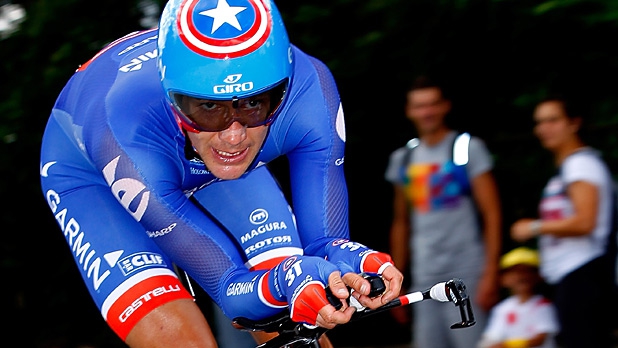Endurance athletes find success with paleo diets.

What do professional cyclist Dave Zabriskie, ultramarathon runner Timothy Olson, and gold-medal triathlete Simon Whitfield have in common? All of these elite endurance athletes have pushed away the time-honored plate of pasta in favor of a "paleo" approach to nutrition. They've dialed down the carbohydrates and replaced them with copious amounts of healthy fat. And as multitudes of paleo converts claim (and anecdotal evidence suggests), this may be the key to optimizing performance and extending careers into the late thirties and beyond.
But it requires a leap of faith. "It's like NASA," says conditioning coach Jacques DeVore on the trepidation he felt sending Zabriskie into the 2013 racing season on an unproved diet. "You can test everything in the lab, but then you put it up in space and sometimes things don't work out."
The 34-year-old American cyclist started working out at DeVore's Santa Barbara gym in October. No stranger to experimentation, Zabriskie competed in the 2011 Tour de France on a mostly vegan diet.
Once he overcame his initial lipid phobia (cyclists live in horror of gaining even trivial amounts of weight), Zabriskie upped the fat in his diet to upward of 60 percent of his caloric intake.
A typical food-log entry listed 3,800 total calories. His meals that day included coconut oil, avocados, eggs, almonds, cashews, chicken breasts, beef jerky, string beans, onions, and protein powder. The nutritional breakdown was 323 grams of protein, 239 grams of fat, and 147 grams of carbohydrate.
He coupled his new dietary approach with high-weight, low-repetition resistance training in the weightroom, as well as hill repeats, jumping squats, and other forms of high-intensity interval training.
The idea behind eating and training "primally" (embracing animal fats, eliminating grains, minimizing carbohydrate intake, and eschewing "chronic cardio" for short, explosive efforts) is to gain strength without gaining weight, train the body to run on fat as a primary fuel source, and naturally maintain high levels of testosterone.
Typically the carbohydrate-heavy diets of pro cyclists coupled with massive amounts of mileage lead to a lowering of testosterone, and by extension, less power on the bike. This explains the appeal of illegally supplementing the hormone – to aid in recovery in multiday stage races.
The results for Zabriskie were impressive, DeVore says. Over the course of their time together the 6-foot cyclist dropped his body weight from 168 pounds to 154 while improving his dead lift from 150 pounds to 245. This while increasing his power on the bike by about 15 percent. He performed well in the Volta a Catalunya, an early-season Spanish stage race, before dropping out in the last stage due to illness.
"I don't think he ever thought he would improve this much," DeVore said. "For a guy who's as elite as he is, and we've added that much power on the bike in one off season? That's huge."
Paleo guru Mark Sisson, former Ironman triathlete and author of the bestselling 'The Primal Blueprint,' used to think that it wasn't possible to be a world-class endurance athlete on a paleo diet – that you just couldn't overcome the need for copious amounts of glucose in the form of carbohydrates without crashing and burning.
"The assumption has always been that glucose was the preferred fuel with regard to performance," Sisson says. "I used to joke back in my days of sugar burning that, ideally, you would hang an IV bag off the back of your bike and just drip glucose into your bloodstream the whole way."
But Sisson has changed his mind. He says that one of the problems with the few studies conducted on low-carb performance to date is that they were done on athletes who had not yet fully adapted to burning fat as a primary source of fuel, a process that can take weeks, if not months. These flawed studies made paleo a tough sell. "This is a leap of faith that a lot of athletes are unwilling to take," he says. "Imagine you've been doing things a certain way for five or 10 years. And all of the sudden some guy comes along and says he thinks there's a better way. But there's no guarantee."
Dr. Stephen Phinney, a professor emeritus at UC Davis, has spent three decades studying low-carb performance. The mainstream consensus has been that you need carbs to do anything other than very moderate intensity exercise. But after a period of adaptation, the body will switch over from carbohydrate to fat as its main fuel for exercise with equal or better performance. That makes an athlete essentially "bonk-proof," says Phinney.
Phinney cited the example of Timothy Olson, who won the 2012 Western States 100, a 100-mile footrace through the High Sierras, in record time on a low-carb, high-fat diet: "He's so skinny it looks like he can take a shower in a shotgun barrel. But even if he's seven or eight percent body fat and only weighs 140 pounds, he still has 25,000 to 30,000 fat calories. If you're about to undertake an event that's going to cost you 14,000 calories, which tank would you like to be hooked into?"
Another benefit of the paleo diet is that it may help extend athletic careers by counteracting the deleterious effects of aging, Phinney says. Typically, below 50 grams of daily carbohydrate intake, the body responds by producing a fuel source from fat called ketone bodies, which also have anti-inflammatory properties that combat oxidative stress.
"As you push performance and training to their limits, you're running up against cumulative oxidative stress that leads to aging," says Phinney. "So if you can use a strategy that counteracts that, it buys you a window of opportunity into longer periods of high-intensity competitive athletics."
Canadian triathlete Simon Whitfield can only laugh when he looks back on his nutrition before linking up with Sisson and dropping carbs early in his career.
"It was so long ago, I can only think about it in general terms," Whitfield says. "But I was like, 'If low fat is good, then no fat must be better.' I thought carb loading was the way to go."
Now his diet includes such paleo staples as coconut oil, bacon, and ghee butter, with a focus on quality fats and proteins and "adequate" carbohydrate supply. He credits the switch with much of his professional success, which consists of 10 consecutive Canadian Triathlon Championship titles, gold in the triathlon at the 2000 Summer Olympics, and silver in 2008. It's also played a role in his athletic longevity: "I think it's a testament to the fact that I'm still doing it at 38, and I'm healthy and injury-free."
Sisson points out that athletes have already done all they can in the realm of who's willing to hurt more. Now they're looking to nutrition. "The next breakthroughs in human performance, in events lasting longer than two hours, will come from this exact method."






